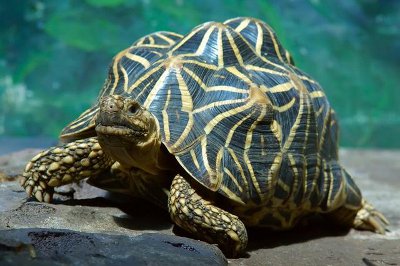Star Tortoise
Category: Turtle

Facts about Star Tortoise. "Scientific name for Star Tortoise is Geochelone elegans". The Star Tortoise is a Geochelone type of tortoise that comes from the Testudinoidea family. The Star Tortoise are native to Sri Lanka, India and the southeastern parts of Pakistan, and they are largely found in arid regions and scrub woodland in those countries. The Star Tortoise is fairly popular in the foreign pet trade. They are the most popular varieties due to their personality, size and look. By means of yellow stripes glowing from the middle of each scute and contrasting with their black pedestal color, the Star Tortoise is one among the most gorgeous tortoise species of the world.
Features of Star Tortoise
Usually, the female Star Tortoise is bigger than the male tortoise, with a maximum body length that ranges from 7 inches to 8 inches (20 to 22 cm), whereas the male Star Tortoise will have a body length between 5 inches and 6 inches (12.7 to 15.2 cm). Star Tortoises from the northwestern part of India and Sri Lanka will grow bigger, and particularly the female tortoises from Sri Lanka may attain a maximum body length of 15 inches (38 cm), whereas the corresponding males will have a body length between 8 and 9 inches (20.3 and 22.8 cm).
The gorgeous star-like designs on the shell of the Star Tortoise, in fact, assist them to mingle with its surroundings effortlessly, in addition to looking extremely pretty. The uniquely marked shell of the Star Tortoises, essentially fragments the firm line of their shell while they are grazing, making these reptiles not so noticeable to their passing predators.
Usually, an adult Star Tortoise prefers an external setup. However, if the type of weather is excessively cold, they prefer indoors. When the Star Tortoises are developed in the captive, their body size plays a vital role in their caging. Hatchlings of the Star Tortoises are developed virtually wholly inside. This protects these tortoises from their predators.
The Star Tortoise breed is vulnerable to breathing problems, which happen when a tortoise experiences the cold climate in the wild or it is maintained in suboptimal conditions in the captive. Symptoms of their breathing problem comprise a nasal discharge, labored breathing, a gaping mouth, lethargy, puffy eyes and a loss of hunger.
The Star Tortoise prefers to live in thorny, semi-arid and grassland homes. It can also be seen in some areas, featuring a higher echelon of rainfall. Not amazingly, known its tendency for grassland homes, the Star Tortoise grazes widely upon diverse grasses.
Diet of Star Tortoise
In the wild, the Star Tortoise grazes and feeds on a range of plants and grasses. In the captive, they are fed with high-fiber foods rich in calcium. The Star Tortoise also fed with greens, grasses, fruits, vegetables, and commercial or prepackaged foods.
Behavior of Star Tortoise
The Star Tortoise is not a good pet for young kids, and they are supposed to be handled rarely. These tortoises are shy that they will withdraw their limbs and head. However, they will usually be trained to identify their keeper and will come for the food. The Star Tortoise is not territorial, too, such that multiple female and male tortoises can be maintained together devoid of the fighting, violent biting and colliding with each other during breeding.
The average lifespan of the Star Tortoise ranges from 30 years to 80 years in the wild, and in the captive, their lifespan is more than 80 years.

 Back To Category Turtle
Back To Category Turtle